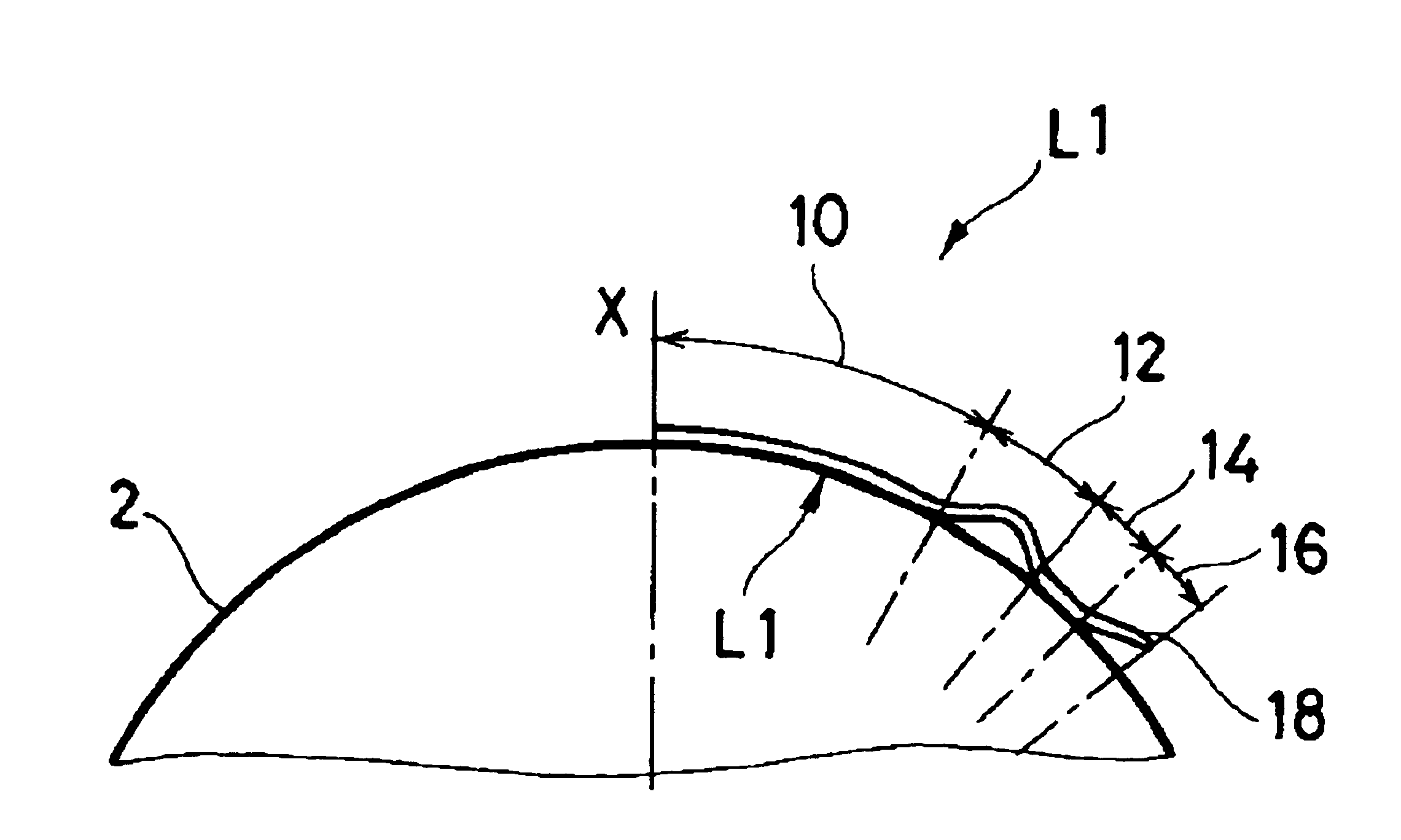Contact lens for correcting myopia and/or astigmatism
a contact lens and astigmatism technology, applied in the field of myopia and/or astigmatism correction contact lenses, can solve the problems of presenting an inherent risk of permanent damage to a patient's eye, many patients are unwilling to undergo these surgical procedures to correct the curvature of the cornea, and the effect of improving the desired shape and functional vision
- Summary
- Abstract
- Description
- Claims
- Application Information
AI Technical Summary
Benefits of technology
Problems solved by technology
Method used
Image
Examples
first embodiment
[0059]The contour and shape of the contact lens L1 are shown in FIG. 4 in an exaggerated form. The contour of the contact lens L1 is designed to treat myopia or astigmatism. In FIG. 4, the contact lens L1 is symmetrical with respect to the axis X.
[0060]The contact lens L1 includes at its center a pressure zone 10 which will overlay or engage a region of the corneal surface where alteration is desired. When the contact lens L1 is placed on the eye, the pressure zone 10 will apply a relative pressure to the underlying or engaged region of the cornea. It is understood that the contact lens L1 is separated from the cornea by fluid, e.g., tears present between the lens and the surface of the cornea but the fluid follows the contour of the cornea.
[0061]The contact lens L1 also includes an annular relief zone 12 positioned at the periphery of the pressure zone 10. The relief zone 12 is an area adjacent to the pressure zone 10 that creates a space or void between the surface of cornea and ...
second embodiment
[0089]A contact lens L2 comprises: a pressure zone 110 having a first surface defined by the inner surface of the contact lens located on the side of a patient's cornea and positioned at the center of the contact lens, wherein the first surface is formed in a concave shape having a curvature less than that of the central surface of the patient's cornea; a relief zone 112 having a second surface defined by the inner surface of the contact lens located on the side of the patient's cornea and positioned at the periphery of the pressure zone 111, wherein the second surface is formed in a concave shape; a first anchor zone 114a having a third surface defined by the inner surface of the contact lens on the side of the patient's cornea and positioned at the periphery of the relief zone 112, wherein the third surface is formed in a concave shape; and a second anchor zone 114b having a fourth surface defined by the inner surface of the contact lens on the side of the patient's cornea and po...
example 1
m With the Features of the Contact Lens L1 of the First Embodiment
[0098]A Japanese patient A initially wore a soft contact lens every day to correct myopia. The patient was diagnosed with myopia through the measurement of refractive error. According to the measurement of the topography of central curves of the right and left eyes, the diopter of the right eye was 38.50 (refractive error: −4.25, uncorrected vision: 0.1) and the diopter of the left eye was 39.00 (refractive error: −4.00, uncorrected vision: 0.1).
[0099]Based on the above measurements, BCs of the contact lenses of the patient's right and left eyes were arranged at 35.50 D and 36.00 D, respectively.
[0100]Then, according to the present invention, RC and AC were determined using the following two formulas.
RC=BC+8.0 D
AC=BC+3.0 D
[0101]As a result, RC and AC of the right eye's contact lens were 43.50 D and 38.50 D, respectively. Further, RC and AC of the left eye's contact lens were 44.0 D and 39.00 D, respectively.
[0102]Then...
PUM
 Login to View More
Login to View More Abstract
Description
Claims
Application Information
 Login to View More
Login to View More - R&D
- Intellectual Property
- Life Sciences
- Materials
- Tech Scout
- Unparalleled Data Quality
- Higher Quality Content
- 60% Fewer Hallucinations
Browse by: Latest US Patents, China's latest patents, Technical Efficacy Thesaurus, Application Domain, Technology Topic, Popular Technical Reports.
© 2025 PatSnap. All rights reserved.Legal|Privacy policy|Modern Slavery Act Transparency Statement|Sitemap|About US| Contact US: help@patsnap.com



